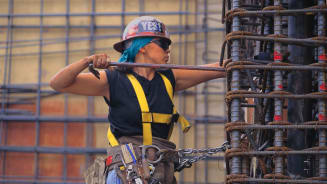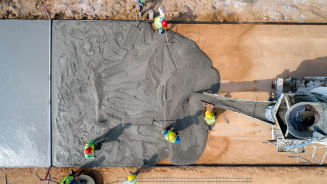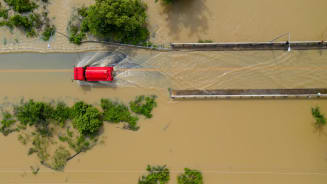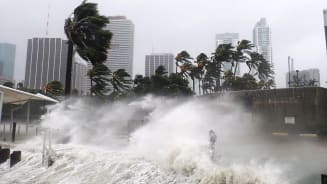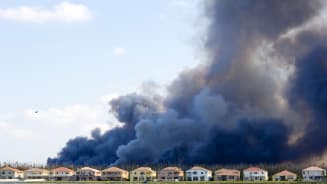How Severe Convective Storms and Shingle Roofs are Becoming a Growing Challenge

As losses from severe convective storms (SCS) continue to increase, insurers are faced with the dual challenge of managing rising claims costs and ensuring the affordability of coverage for their customers.
Key Takeaways
-
Asphalt shingle roofs, which cover nearly 75% of single-family homes in the U.S., are highly vulnerable to damage from severe convective storms (SCS), as early as 8-10 years after installation.
-
The increase in SCS insured losses over the past decade can be attributed to exposure growth. As more properties are built in high-hazard areas, the potential for large-scale losses from SCS events increases.
-
Both policyholders and insurers play crucial roles in reducing losses from SCS events. Policyholders can help with regular maintenance and timely repairs of shingle roofs, while insurers should capture roof cover and age data for more accurate underwriting.
Severe convective storms (SCS) have become a significant concern for the insurance industry, particularly in relation to the durability and longevity of asphalt shingle roofs. This article delves into the impact of the peril, particularly straight-line wind impacts, on shingle roofs, explores the implications for insurers and the insured, and suggests potential insurer strategies for mitigating losses and maintaining profitability while serving their policyholders.
Increased Vulnerability of Shingle Roofs
Asphalt shingles are a common roofing material in the U.S. with nearly 75 percent of single-family homes using this type of roof covering. Recent findings indicate that these roofs are far more vulnerable to damage from SCS than previously thought. A post-event aerial imagery study conducted by IBHS following the 2020 Midwest Derecho offered valuable insights into performance of asphalt shingles in an SCS event. It revealed that asphalt shingle roofs are extremely susceptible to straight-line wind damage as early as 8 to 10 years after installation despite the 20-25 year lifespan advertised by roofing manufacturers. This shorter lifespan can lead to increased insurance claims frequency through more frequent roof replacements.


Did you know?
- By the time a roof is eight years old it has a 1-in-4 chance of at least some damage from a severe convective event.
- A ten year old roof is nearly completely destroyed by a severe convective event that produces wind speeds above 100mph.
105%
Every year since 2019 the reported industry combined ratio for homeowners business was 105 or worse.
Source: Homeowners Return on Equity Outlook 2024
The Joint Challenge for the Insurer and the Insured
The increased frequency of asphalt shingle roof replacements presents a profitability challenge for insurers.
The current types of insurance cover offered to policyholders may need to be adjusted in a way that implements a different deductible structure for roofs compared to the rest of the home. An alternative option is to explore co-pays for roof repairs or replacements, thereby sharing the financial burden between the policyholder and the insurer for the roof only. As insurers seek to strike a balance between providing adequate coverage and maintaining profitability, policyholders will also need to take a more active role in maintaining their properties to prevent damage to the roof from these types of perils.
Mechanisms to manage profitability
- Increase premiums
- Increase deductible
- Separate peril deductible
- Varied deductible structure dependent on roof age/material type
- Actual cash value roof policy dependent on roof age/material type
Exposure Growth Versus Climate?
A significant portion of the increase in SCS insured losses over the past decade can be attributed to exposure growth rather than a fundamental change in the nature of the risk. Since 1990, SCS losses have increased at an average annual rate of 9.4 percent. As more properties are built in high-hazard areas, the potential for large-scale losses from SCS events increases.
To prove this, we identified four main drivers of exposure change and quantified how much of the overall SCS loss trend they explained.
- Real gross domestic product (GDP) accounts for how much “stuff” there is in the economy and grew at an annual rate of 2.4 percent.
- Fixed reproducible tangible wealth (FRTW) accounts for how much goods and services are worth and grew at an annual rate of 2.1 percent.
- Property cost inflation, measured by the producer price index for all construction, provides a good estimate of how construction costs change over time. This grew the fastest at a 3.0 percent rate.
- Population distribution, measured by the housing distribution index, is based on changes over time in housing units in high hazard states like Texas and other Sun Belt states. It grew at a rate of 1.1 percent.

Loss Mitigation and Reduction Strategies – Everyone can Play a Part
Policyholders and insurers have a role to play in mitigating and reducing losses from SCS events.
Policyholders: regular maintenance and timely repairs of shingle roofs can significantly reduce the likelihood of severe damage. Educating homeowners about the importance of roof upkeep and providing incentives for proactive maintenance can help lower claims frequency.
Insurers: appropriately capturing roof cover and roof age data is key so that insurers can accurately underwrite and price the risk while providing targeted risk advice and adaptation solutions.
Best-in-class insurers carefully manage SCS risk by understanding the dynamic nature of the peril.
- Monitor peak exposure concentrations and understand location level risk
- Implement a holistic view of SCS cost drivers in pricing to ensure rate adequacy
- Consider the strengths and weaknesses of catastrophe models and leverage those that reflect the latest view of SCS trends and historical experience
- Proactively track catastrophe events using real-time data sources to assess event impacts as they unfold to ensure that claims are settled quickly and efficiently to minimize loss settlement costs.
Conclusion
The increasing frequency and severity of severe convective storms pose a significant challenge for the insurance industry, particularly in relation to asphalt shingle roofs. As these roofs demonstrate a shorter lifespan and higher vulnerability to damage, insurers must adapt their strategies to manage rising claims costs and maintain profitability. Collaboration between policyholders and insurers in loss mitigation efforts will be crucial in achieving a long-term, profitable equilibrium in the homeowners' insurance market as both parties navigate this evolving landscape of SCS related losses.
General Disclaimer
This document is not intended to address any specific situation or to provide legal, regulatory, financial, or other advice. While care has been taken in the production of this document, Aon does not warrant, represent or guarantee the accuracy, adequacy, completeness or fitness for any purpose of the document or any part of it and can accept no liability for any loss incurred in any way by any person who may rely on it. Any recipient shall be responsible for the use to which it puts this document. This document has been compiled using information available to us up to its date of publication and is subject to any qualifications made in the document.
Terms of Use
The contents herein may not be reproduced, reused, reprinted or redistributed without the expressed written consent of Aon, unless otherwise authorized by Aon. To use information contained herein, please write to our team.
Aon's Better Being Podcast
Our Better Being podcast series, hosted by Aon Chief Wellbeing Officer Rachel Fellowes, explores wellbeing strategies and resilience. This season we cover human sustainability, kindness in the workplace, how to measure wellbeing, managing grief and more.
Aon Insights Series Asia
Expert Views on Today's Risk Capital and Human Capital Issues
Aon Insights Series Pacific
Expert Views on Today's Risk Capital and Human Capital Issues
Aon Insights Series UK
Expert Views on Today's Risk Capital and Human Capital Issues
Construction and Infrastructure
The construction industry is under pressure from interconnected risks and notable macroeconomic developments. Learn how your organization can benefit from construction insurance and risk management.
Cyber Labs
Stay in the loop on today's most pressing cyber security matters.
Cyber Resilience
Our Cyber Resilience collection gives you access to Aon’s latest insights on the evolving landscape of cyber threats and risk mitigation measures. Reach out to our experts to discuss how to make the right decisions to strengthen your organization’s cyber resilience.
Employee Wellbeing
Our Employee Wellbeing collection gives you access to the latest insights from Aon's human capital team. You can also reach out to the team at any time for assistance with your employee wellbeing needs.
Environmental, Social and Governance Insights
Explore Aon's latest environmental social and governance (ESG) insights.
Q4 2023 Global Insurance Market Insights
Our Global Insurance Market Insights highlight insurance market trends across pricing, capacity, underwriting, limits, deductibles and coverages.
Regional Results
How do the top risks on business leaders’ minds differ by region and how can these risks be mitigated? Explore the regional results to learn more.
Human Capital Analytics
Our Human Capital Analytics collection gives you access to the latest insights from Aon's human capital team. Contact us to learn how Aon’s analytics capabilities helps organizations make better workforce decisions.
Insights for HR
Explore our hand-picked insights for human resources professionals.
Workforce
Our Workforce Collection provides access to the latest insights from Aon’s Human Capital team on topics ranging from health and benefits, retirement and talent practices. You can reach out to our team at any time to learn how we can help address emerging workforce challenges.
Mergers and Acquisitions
Our Mergers and Acquisitions (M&A) collection gives you access to the latest insights from Aon's thought leaders to help dealmakers make better decisions. Explore our latest insights and reach out to the team at any time for assistance with transaction challenges and opportunities.
Navigating Volatility
How do businesses navigate their way through new forms of volatility and make decisions that protect and grow their organizations?
Parametric Insurance
Our Parametric Insurance Collection provides ways your organization can benefit from this simple, straightforward and fast-paying risk transfer solution. Reach out to learn how we can help you make better decisions to manage your catastrophe exposures and near-term volatility.
Pay Transparency and Equity
Our Pay Transparency and Equity collection gives you access to the latest insights from Aon's human capital team on topics ranging from pay equity to diversity, equity and inclusion. Contact us to learn how we can help your organization address these issues.
Property Risk Management
Forecasters are predicting an extremely active 2024 Atlantic hurricane season. Take measures to build resilience to mitigate risk for hurricane-prone properties.
Technology
Our Technology Collection provides access to the latest insights from Aon's thought leaders on navigating the evolving risks and opportunities of technology. Reach out to the team to learn how we can help you use technology to make better decisions for the future.
Top 10 Global Risks
Trade, technology, weather and workforce stability are the central forces in today’s risk landscape.
Trade
Our Trade Collection gives you access to the latest insights from Aon's thought leaders on navigating the evolving risks and opportunities for international business. Reach out to our team to understand how to make better decisions around macro trends and why they matter to businesses.
Weather
With a changing climate, organizations in all sectors will need to protect their people and physical assets, reduce their carbon footprint, and invest in new solutions to thrive. Our Weather Collection provides you with critical insights to be prepared.
Workforce Resilience
Our Workforce Resilience collection gives you access to the latest insights from Aon's Human Capital team. You can reach out to the team at any time for questions about how we can assess gaps and help build a more resilience workforce.
More Like This
-

Article 4 mins
5 Steps for Successful Carbon Accounting Verification
Organizations can demonstrate their commitment to global sustainability and a low-carbon future by addressing verification challenges and adopting best practices.
-

Article 15 mins
Management Liability Insurance Market in 2025: Stability Amid Evolving Risks
Market stability prevails in management liability lines as insurers continue to seek market share. However, expanding technologies, increased litigation and macroeconomic factors are causing growing uncertainty and underwriting concerns.
-

Article 7 mins
A Comprehensive Approach to Financial Wellbeing
There is an opportunity to develop a strategy around financial education in the workplace. Globally, our latest data finds 11 percent of employees receive financial education from their employer, but 37 percent expect it. How can employers bridge this gap?


























